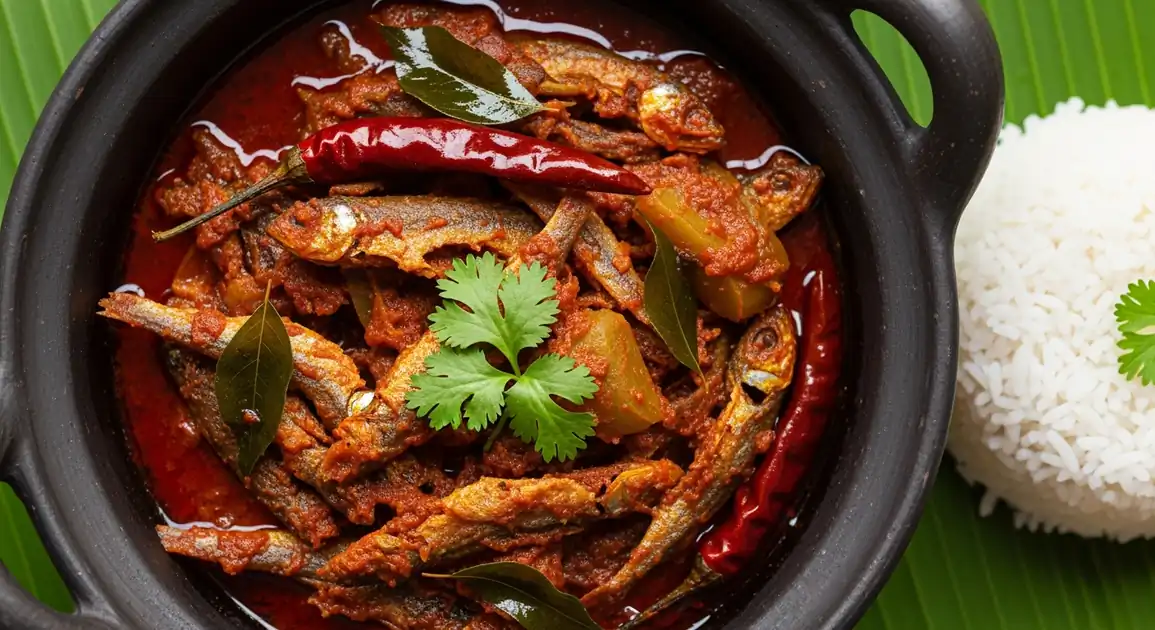Hal Messo (Fish Curry)
හාල් මැස්සෝ

Description
In Colombo, Sri Lanka's bustling capital, Hal Messo reflects the city's diverse culinary landscape – from street-side stalls to upscale restaurants. The fish curry here often balances traditional flavors with urban adaptations, catering to both local tastes and international visitors. Colombo vendors typically source fish from the nearby Negombo and Beruwala fishing harbors.
Dietary Information
Serving information
Serving style
Urban eateries serve in small clay pots or bowls alongside rice. Street vendors often use disposable containers with banana leaf lining. Higher-end restaurants may present a more refined plating with garnishes.
Quick facts
Lunch venues: 11 AM - 3 PM. Evening street food: 5 PM - 10 PM. Restaurants: Often 11 AM - 10 PM.
Safety Tips
What to Look For
-
Clear, vibrant red curry sauce with visible spices
Quality Hal Messo has a distinct red-orange color from fresh spices, not a dull or brownish appearance which could indicate old spices or reheated curry.
-
Firm, intact fish chunks
The fish should hold its shape when lifted with a spoon, not fall apart easily. Mushy or disintegrating fish often indicates old or poor quality fish.
-
Fresh, aromatic smell of spices without fishiness
The dominant aroma should be of curry leaves, goraka, and spices. Any strong fishy smell suggests the fish isn't fresh.
-
Clay pot cooking (traditional method)
Clay pots help slow-cook the curry and develop flavors better than metal pots, often indicating more traditional preparation methods.
-
Visible curry leaves and pandan leaves
Fresh herbs are essential to authentic Hal Messo and indicate attention to traditional preparation.
What to avoid
-
Watery, thin curry sauce
Good Hal Messo has a somewhat thick consistency. Overly watery curry might indicate it's been diluted to stretch portions or hasn't been prepared properly.
-
Pre-cooked fish added to curry sauce
Traditional Hal Messo cooks the fish in the spice mixture. Some vendors take shortcuts by adding pre-cooked fish to sauce, resulting in less flavorful dishes.
-
Strong ammonia or fishy smell
This indicates the fish is not fresh and could potentially cause food poisoning. Fresh fish has a mild sea scent, not a strong fishy odor.
-
Floating oil with strange color
Excessive oil separation with unusual coloration could indicate old oil or curry that's been repeatedly reheated.
-
Very pale or grayish fish
Fresh tuna should have a pinkish to reddish-brown color when cooked. Gray or very pale fish suggests poor quality or old fish.
Price information
Price range
Budget tips
- Street food areas like Galle Face Green offer affordable versions (200-350 LKR).
- Local 'bath kades' (rice shops) typically charge 250-400 LKR for Hal Messo with rice.
- Pettah Market food stalls provide good value versions during lunch hours.
- Maritime neighborhoods like Dehiwala and Mount Lavinia often have reasonably priced, authentic options from fishing communities.
Value indicators
- Fish source is mentioned (e.g., 'Negombo tuna').
- Curry made fresh that morning rather than from previous day.
- Clay pot preparation (traditional method).
- Generous fish-to-sauce ratio.
- Complementary rice and condiments included.
Where to Find This Dish
Pettah
The bustling market area has numerous small eateries serving affordable Hal Messo, especially during lunch hours.
Main Market, Old Town Hall, Floating Market
Lunch (11 AM - 2 PM)
Galle Face Green
The oceanfront promenade features evening food stalls with fresh seafood options, including Hal Messo.
Galle Face Hotel, Beach strip
Evening (5 PM - 9 PM), Weekends
Dehiwala/Mount Lavinia
This coastal suburb has authentic seafood eateries run by fishing communities.
Mount Lavinia Beach, Dehiwala Junction
Lunch, Dinner
Wellawatte
This neighborhood with significant Tamil influence offers unique variations of the dish.
Wellawatte Market, Ramakrishna Road
Evening (6 PM - 9 PM)
Vendor Tips
- Look for busy local lunch spots with 'Rice & Curry' signs displaying Hal Messo as an option.
- In tourist areas, specify if you want authentic spice levels rather than toned-down versions.
- Some Colombo vendors distinguish between 'local style' and 'tourist style' - ask for 'local style' for authenticity.
- Morning-prepared curry often develops better flavor by lunchtime.
How to Order
Regional Variations
-
Muslim-style Hal Messo
(මාරකල් හාල් මැස්සෝ)
Found in Colombo's Muslim neighborhoods like Maradana and Dematagoda, featuring distinctive spicing with extra fennel and sometimes dried chili.
-
Tamil-influenced Version
(දෙමළ හාල් මැස්සෝ)
Found in Wellawatte and Bambalapitiya areas, often incorporating curry leaves more prominently and sometimes using fish head pieces.
-
High-end Restaurant Adaptation
(සුපිරි අවන්හල් හාල් මැස්සෝ)
Upscale Colombo restaurants offer refined versions with premium fish cuts, carefully balanced spices, and elegant presentation.
-
Negombo Style in Colombo
(මීගමුව හාල් මැස්සෝ (කොළඹ))
Vendors with connections to Negombo (suburb north of Colombo) offer their regional style, known for balanced spice and thicker gravy.
Cultural context
History
Hal Messo has deep roots in Sri Lanka's coastal culinary tradition, evolving from the island's rich maritime heritage. The name derives from 'Hal' (rice) and 'Messo' (fish), reflecting its status as an essential accompaniment to rice meals. Historically prepared in coastal fishing communities, the recipe has been passed down through generations, with each family maintaining slight variations. The introduction of goraka as a preservative ingredient was crucial in times before refrigeration, allowing the curry to keep for several days.
Local significance
In Colombo, Hal Messo represents the blending of coastal traditions with urban dining culture. It's a popular office lunch choice and weekend family meal.
Eating customs
- Urban diners often eat with spoon and fork, though traditional hand eating is still common.
- Often accompanied by papadam and several vegetable side dishes.
- Local eateries typically serve unlimited rice with your curry order.